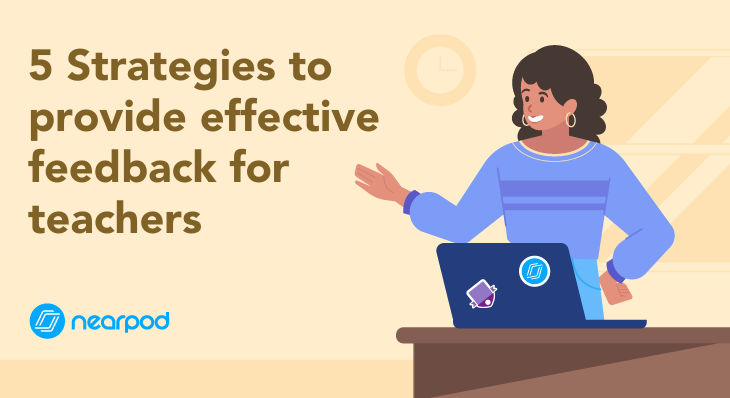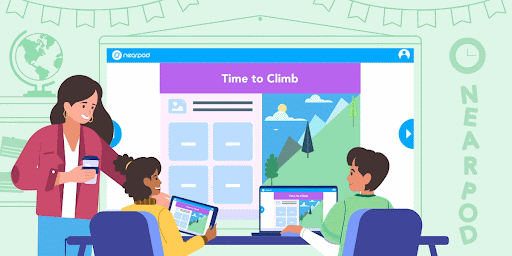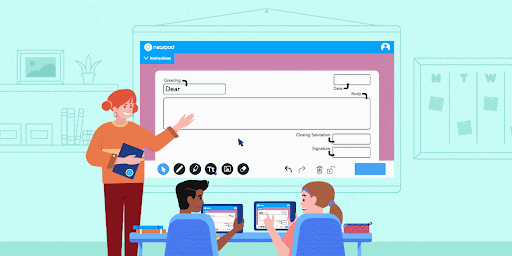
5 Strategies to provide effective feedback for teachers
How to create a supportive feedback culture for teachers
As a school leader, providing feedback for teachers that is effective and supportive is crucial for maximizing their impact on student learning. As a teacher, it can be intimidating to have your administrator walk into your classroom, especially if it is not a common practice. Anxiety can be driven even higher when they begin to write notes. Thoughts can go racing through a teacher’s mind which can cause them to lose focus on the most important task in front of you, teaching your students. As a veteran teacher and now school administrator, my message is clear: Teachers should not have to fear you coming into their room.
Being watched or evaluated is certainly something that can drive nerves, especially for teachers who have had negative experiences, are new to the profession, or experience anxiety or stress. But as school leaders, it is our responsibility to create an atmosphere that supports growth and learning from one another, no matter who is in the room. This often comes in the form of coaching but is rooted in a culture of trust and credibility. By offering good feedback, school leaders can empower their team members to refine their teaching methods and support student success.
5 Strategies to provide effective feedback for teachers from an administrator
I have worked hard across the schools I have been a leader in to build this trust and credibility with my teachers so that my presence in the classroom is not seen as punitive or a distraction but rather an opportunity to receive feedback and ideas for their classroom. The following are suggestions for school leaders and aspiring school leaders to build into their teacher-coaching models.
New to Nearpod? Administrators can schedule a call to learn about the full instructional power of Nearpod for your schools and districts. Teachers can sign up for free below to access and create interactive lessons.
1. Be visible to teachers and students daily
It can be downright hard sometimes to get out of your office as an administrator. Phone calls, emails, meetings, and paperwork fill your agenda; before you know it, it’s almost time for dismissal. Visibility matters. Being present inside classrooms and in the hallways helps inform you about what is happening across the school. To combat the difficulty of breaking free of the office, I used to block off 30-90 minutes each day in my calendar solely dedicated to classrooms. That does not mean I could not spend more time with them, but I knew that if it was scheduled into my calendar, nothing else would get put on my schedule at that time.
The key was doing this daily. It was not a once-a-month or quarter surprise. Students and teachers became accustomed to seeing me, and I made it clear that if I’m in the room, feel free to use me to help with whatever is going on. Constructive feedback, incorporated into regular performance reviews and visits, fosters a culture of continuous improvement within the school community. Explore this blog post if you’re looking for examples of teacher feedback to students.
When I went into classrooms, I didn’t necessarily have an agenda. I sought ways to help a struggling student, or sometimes I would just enjoy the lesson and participate. The kids especially loved it when I would join them in a round of Time to Climb or an interactive trivia slide. As a new administrator in a building, it’s a great way to get to know the students and teachers.
2. Model teaching in the classroom
Credibility matters. People want to know that you’re not asking them to do something you’re unwilling to do yourself. One of the most important tenets of my leadership philosophy is never forgetting where the magic happens – in the classroom. The best way I can support that is to model how the magic should be created. As a principal, I taught at least one lesson weekly in a classroom. Sometimes it was a full lesson. Other times it was just a quick read-aloud. But the idea was that I wanted to model the engagement, rigor, questioning, and instructional strategies that I was asking my teachers to perform.
I am not an expert in every grade level across every subject. This is where having a technology tool like Nearpod can be helpful. Suppose the classroom teacher creates a Nearpod lesson, and it’s not an area I am comfortable with. In that case, I can facilitate the learning through Nearpod and model classroom management and strategies versus trying to master the content.
When discussing modeling lessons, I often get asked, “How did you get your teachers to let you teach?” I started by offering it to anyone interested. I had a few takers. From there, word got around that it was a fun experience and a chance to watch someone else teach. After a while, I had more requests roll in, and then there were some classrooms where I called them to have a model lesson in their room so a specific strategy could be demonstrated. Eventually, it simply became part of the school’s culture.
3. How to use F.A.C.T.S. for coaching teachers
Building credibility and visibility across the building gave me a leg up on eventually offering feedback to teachers on the instruction I observed. When coaching is specific, actionable, fair, consistent, and timely (or rearranged as Fair, Actionable, Consistent, Timely, Specific = F.A.C.T.S), teachers see this feedback as opportunities for growth. Teachers were accustomed to having me in the classroom, and many had seen me teach at this point. As a school leader, I needed to make sure that I was providing feedback for teachers now to improve the instruction across the building.
When coaching is specific, actionable, fair, consistent, and timely, teachers see this feedback as opportunities for growth, not “gotcha” moments. Building a culture encompassing these principles allows for transparency and open discourse around best practices, which can yield improved achievement and outcomes. This can also be helpful tips for student feedback.
Here are five pillars for providing your coaching feedback using F.A.C.T.S.:
Fair
Of course, the actionable items and feedback need to be fair. Unreasonable goals or timelines set people up for failure and frustration and push culture back steps. Again, using the previous example, if a statement like “You need to get rid of your desk and chair by lunchtime” was stated in response to better engagement, there would likely be resentment in that type of demand.
Actionable
Effective feedback for teachers should be actionable. Putting timelines or expectations behind those comments will lead to quicker action. For example, “Please see me before school tomorrow so we can come up with the plan for sharpening pencils so you can introduce it at the start of the day” gives specific times and expectations for making the change. Some things will require longer, but actionable feedback and steps help people make the task attainable.
Consistent
Returning to the previous commentary on credibility, feedback should be consistent. Popping in once a quarter or twice a school year for mandatory classroom observations does not provide an adequate look into what is truly happening in the building. If you are going to give principal feedback to teachers about instruction, you need several data points to make an objective evaluation. Consistency in your feedback will show trends and opportunities for improvement over time. Additionally, providing positive feedback for teachers consistently is important. Using the aforementioned calendar approach is a helpful way to do that.
Timely
Timely feedback is essential. If you went up to a student and told them that you were disappointed in their behavior from last week, they might act confused or disconnected from the comments since they happened days ago. The same goes for our coaching. Feedback for teachers should be offered ideally within 24 hours so it is still fresh in the minds of the teacher and administrator. This helps teachers improve their instructional practices and directly influences how students achieve academically.
Specific
When providing feedback, it needs to be specific. Vague comments like “More engagement is needed” or “Stronger classroom management” are unproductive toward improvement. Adjusting those comments to “Moving out from behind your desk will help allow you to move about the classroom” or “Let’s work together with coming up with a pencil sharpening routine, so everyone is not standing in line” are more specific attempts at improvement.
4. Deliver the feedback seamlessly
Providing coaching feedback can come in several forms. I prefer less paper, so I have created walk-through forms using Google Forms, which automatically and immediately send my comments to the teacher upon pressing submit.
Within the form, I always leave a space for open responses so I can narrate my thoughts and observations beyond just a checkbox or radial button. I was always frustrated when I got teacher observation feedback that was marked simply as “Exceeds,” “Meets,” or “Does not meet” on a question. It doesn’t give context around what you actually witnessed, so I aim to be descriptive and qualitative in my feedback in order to provide concrete commentary back to the teacher.
Occasionally, there are moments when a face-to-face meeting is necessary to go more in-depth with coaching. In those situations, I utilize a few strategies to make the meetings productive and positive for both parties. Sorry, no acronym for this one!
How to properly address feedback to coach teachers in person
When the situation calls for a face-to-face meeting, I typically hold it in their classroom. This allows the teacher to feel more comfortable since it is “their turf.” It also allows me to do the next thing: model and recreate situations. If I am referencing a specific moment in the class from my observation, it is easier to point to a desk or stand in the spot where it actually happened. Materials are also more readily available inside the teacher’s classroom, which will help when planning for a future lesson or reviewing what was done that day. This can also be helpful for teacher to teacher feedback.
When approaching conversations where feedback is given, my goal is to ask more questions than give answers. This reflective practice is what leads to self-discovery, which is far more powerful than simply telling a teacher what needs to be fixed. For example, if during a remediation lesson, I saw a teacher give every student in the class the same worksheet to practice, I would be concerned because there’s a chance that there were students in the class who were already proficient on the content based on the assessment results.
Instead of simply explaining this, I may ask questions like “What trends did you notice based on the summative assessment?” or “Based on your data, what led you to use this worksheet for a review for all students?” Perhaps there was a good reason. Maybe the teacher did think this through and questioning instead of telling opens the door for the teacher to explain their thinking. From there, we can have a conversation stemming from the teacher’s response.
3. Before finishing any coaching meeting, I have two important practices that I employ:
- In the first practice, I work with the teacher on a realistic plan of action. Going back to the F.A.C.T.S. model, actionable items help facilitate progress. Establishing an agreed-upon action and timeline provides accountability and focus moving forward. From the example above, if the teacher reflected and believed that their worksheet was not differentiated based on the data, we might come up with an action item that said that tomorrow’s remediation materials would be differentiated based on the specific needs of the student. It gives a specific action (i.e. differentiated materials) and a timeline (i.e. tomorrow’s lesson).
- The second practice I end any coaching meeting with is with one simple phrase: What can I do to help you? This phrase is impactful because it shows that we are in this together. If we want our students to be successful, we need to make sure teachers feel and are fully supported. In asking this question over the years, I have had answers ranging from “I’m good” to supply requests to follow-up meetings to help from specialists in the building. Who knows what you need better than you? Now, am I one hundred percent of the time able to fulfill the requests? No. But if I am not, I will work with my teacher on finding alternative ways to get what they need to be successful.
5. Follow up and check-in
Just because a meeting is complete, it does not mean sudden change. Just because you devise a plan of action, it does not mean it will be implemented. That is why following up and checking in with the teacher is so important. The coaching shouldn’t end. This can be part of the actionable steps before a meeting is complete. Establishing a follow-up meeting date, a scheduled observation, peer observation, or a model lesson are good ways to put accountability on all parties to do the things they said they would do.
Start sharing effective feedback using Nearpod
As an administrator, my goal is to build relationships and trust with my staff so that even if my teacher does get a faster heartbeat when I walk in, it is not a fear of consequence or punishment that overcomes them. I hope that coaching, in my teachers’ eyes, is seen as an opportunity for reflection, conversation, and growth.
New to Nearpod? Administrators can schedule a call to learn about the full instructional power of Nearpod for your schools and districts. Teachers can sign up for free below to access and create interactive lessons.

Adam Dovico has served as a teacher, curriculum facilitator, principal, and college professor. He has traveled around the world conducting professional development for tens of thousands of educators. He is the author of three books: Inside the Trenches, The Limitless School, and When Kids Lead.








